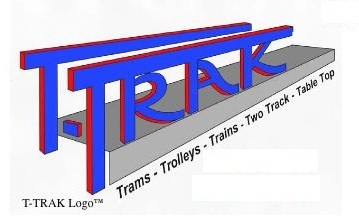This website has been archived from TrainWeb.org/ntxttrak to TrainWeb.US/ntxttrak.
T-Trak History
Lee's original modules were shown at the N-Scale convention in St. Louis in the summer of 2001. The Yahoo T-Trak Forum started in October of 2002 and the T-Trak website was announced in Feb 2003. From that point, discussions regarding standards and colloborative efforts began in earnest. By the summer of 2003, the idea of T-Trak was spreading fast within the model railroad community and modules were being built by early adopters across the US. Some of this early growth was due to the availability of plastic Shapemaster module kits released in January of 2003 while others built their own module bases due to the simplicity of the standard.
In 2009 the largest layout to date, featuring 230? modules, was assembled for the Yadda Yadda N-Scale Convention in Somewhere, US. The adoption of T-Trak modeling continues to grow, in both the US and internationally, with 69 known clubs actively supporting T-Trak.
The History of T-Trak
A Circle of Friends
by Lee [Monaco-FitzGerald]
I read a book called "No Man Is An Island." A few words but a strong statement. I think that no matter what occurs, the happening is influenced by surroundings, previous occurences, and people that one meets. We can strive to produce something, however small, to be beneficial to others, and given freely. This certainly applies to NTRAK and T-TRAK.
In 1975, Jim shared NTRAK knowledge with interested Japanese prospective modelers, who established a club, producing wonderful NTRAK Modules and the seeds were planted for growth of the hobby there.
In 2000, we were invited to share and bring NTRAK modules to the first JAM Convention in Japan. At a private conference we were shown a board with 2 pieces of Kato Unitrack held to it, in mid-air, and told about an editor making a paper tram (Trolley), and placing it on an A4 piece of paper and asked our thoughts. There were no modules at that time.
This was the first time I had ever seen Kato Unitrack. My club in Philadelphia used traditional track and taught me how to build an NTRAK module in 1982. To me this was another art form. I built my first Z track display also. I had been building assorted displays using different methods and skills, before modules, including intricate stained glass displays.
For 13 years I built 40' of scenicked NTRAK modules in Philadelphia, including almost as much footage for the Dimensional Murals that I designed-- Scenery to the floor and many enclosed in a case, to hang on the wall as a Dimensional Mural. In California, the designing and building continued, and I added 8' each of NTRAK modules and Dimensional Murals, all totaled 48' of NTRAK modules, 42' of Murals, plus other scales and displays. I spoke to many people at shows, and vowed that I would find a solution for those who couldn't model for various reasons. When I saw those 2 pieces of Kato Unitrack and my experience with modules, I had found my answer.
We bought 4 of those craft-type boards: #1 was used as the base for a stream under a bridge; #2 a subway and city above; #3 A carnival using collectibles and a working ride, was built as a T-Trak standard base. The craft boards were not really available here, difficult to convert and no longer used. It was easier to build the modules directly. Modules in any scale are based on the Manufacturers roadbed sizes.
I took the first three to the St. Louis July 2001 Train Show. They were placed on a plain NTRAK module, in the layout, with a photo of Japanese tram modules from their magazine (with permission to print them) propped up in the back. The Japanese photos were in the centerfold of the NTRAK Newsletter as well. We did not know at the time that they were called "Romen-Trolleys in the Street."
With my three T-TRAK modules we attended the 2nd JAM Convention in Japan in August 2001, and saw their many modules for the first time. The Unitrack allowed easy connection.
The Sept/Oct 2001 [NTRAK] Newsletter introduces T-TRAK and T-TRAK Modules on the cover, and due to space limitations, the photo captions were placed on page 13, last column, with no identity. The remainder of the centerfold showed the Japanese Tram/Romen modules. The tram module concept refers to the "tracks on board" shown to us. Page 14 shows the 3 T-TRAK modules with the tram photo in the back.
My first T-TRAK modules presented the Basic [track spacing] standard for trolleys and 4-axle trains, followed by the Alternate standard module for 6-axle trains. T-TRAK grew in sizes and on to other scales.

This photo was printed on page 14 of the T-TRAK article, Sept/Oct 2001 [NTRAK] Newsletter.
Note: I can now see that introducing both types of modules together has caused confusion. Be assured that "T-TRAK" was "Created in America" by me and did not come from Japan.
"Romen-Trolleys in the Street" was "Made in Japan." This was verified by the esteemed Dr. and modeler friends from Japan who attended the 2004 Chantilly Convention. The Dr. had a film showing the Romen-Trolleys in the Street concept from Japan and the T-TRAK concept by Lee Monaco-FitzGerald.
The point of this article is that incorrrect information has been spreading that T-TRAK came from Japan, due to early misinterpretations through the internet mostly. In the beginning, I had much resistance to the idea because it was a new concept and I had to convince people that T-TRAK was a good addition to the hobby. It was not easy convincing Jim, as well, before I could introduce the idea in the newsletter. It is now immensely popular and growing.
The Circle of Friends is still growing. Former Romen modules are now shown in the T-TRAK pages of the interesting RM Magazine.
Welcome!















